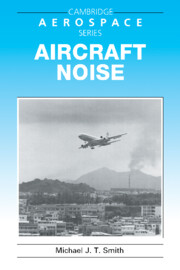Book contents
- Frontmatter
- Contents
- Preface
- Acknowledgments
- 1 Human reaction to aircraft noise
- 2 Action against aircraft noise
- 3 Aircraft noise sources
- 4 Power-plant noise control
- 5 Concorde – a special case
- 6 Noise data acquisition and presentation
- 7 Aircraft noise prediction
- 8 Prospects for the future
- 9 Review
- Appendices
- References
- Index
2 - Action against aircraft noise
Published online by Cambridge University Press: 06 November 2009
- Frontmatter
- Contents
- Preface
- Acknowledgments
- 1 Human reaction to aircraft noise
- 2 Action against aircraft noise
- 3 Aircraft noise sources
- 4 Power-plant noise control
- 5 Concorde – a special case
- 6 Noise data acquisition and presentation
- 7 Aircraft noise prediction
- 8 Prospects for the future
- 9 Review
- Appendices
- References
- Index
Summary
The noise from the early pure jet and low-bypass turbofans was, in hindsight, wholly unreasonable. The public should never again be permitted to suffer such intrusion on sleep, conversation and relaxation without adequate redress via compensation from the aircraft suppliers and operators, or the customers who benefit from the service provided. Air travel has penetrated international frontiers, brought nations closer together and boosted world markets but, in the main, it is a luxury that pampers the business community and the tourist on a daily basis. Without air transportation, many people would not have the pleasure of visiting the numerous faraway places that are now readily accessible to them in a comparatively short travelling time. Similarly, on the commercial front, mail and freight services would be slower and the wide variety of perishable goods currently available would no longer be able to reach world markets. Business travel, which frequently represents the backbone of the revenue from passenger operations, would be reduced to the essential minimum, but the world would still manage, perhaps at a less frantic pace!
In order to enjoy the many benefits of air transportation, many people have had to suffer high levels of noise intrusion, in most cases, not of their own choice. Airports have expanded, many new ones have appeared, and “noise-impacted zones” have spread to embrace areas that have traditionally enjoyed an element of serenity. Although few people have seriously suggested that aircraft noise is detrimental to health, the impact of noise in general, and of aircraft noise in particular, has been, and still is, the subject of wide-ranging debate.
- Type
- Chapter
- Information
- Aircraft Noise , pp. 20 - 40Publisher: Cambridge University PressPrint publication year: 1989
- 1
- Cited by



